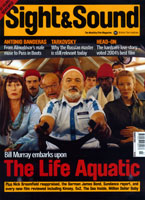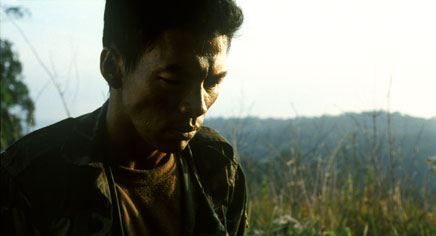
Tropical Malady
France/Thailand/Germany/Italy/Switzerland 2004

Reviewed by Roger Clarke
Synopsis
Our synopses give away the plot in full, including surprise twists.
A group of Thai soldiers have found a body and are preparing to transport the corpse from near the jungle. There's a stop for the night at a tiny farm. Soldier Keng (Banlop Lomnoi) meets country boy Tong (Sakda Kaewbuadee). There follows a courtship. Tong works in an ice-factory in town and Keng agrees to teach him to drive. They attend a clinic together when Tong's dog falls sick with cancer. At an outdoor singing venue a singer dedicates a song to Keng of the Forest Patrol MO21, and Tong joins her in a duet. Keng also spends time on the farm. The first section ends with the news that a monster from the jungle is killing cattle. After a hungry, sensual moment Tong mysteriously leaves Keng and walks off into the night.
There is an interlude about a Khmer shaman who could turn into a tiger.
The second section of the film is entitled ‘A Spirit's Path'. A soldier is in the forest, frightened. An initial tussle with the demented shaman, naked and tattooed, leaves him bruised and battered. A talking baboon in a tree tells him his destiny is with this man-beast. But after laying a trap and sitting out a night-time vigil, he only manages to shoot a cow and watch its ghost drift away. The film ends with the soldier looking up at a ghostly tiger poised in a tree. A poetic caption is subtitled: "Monster, I give you my spirit, my flesh and my memories."
Review
With this winner of the Prix du Jury in Cannes in 2004 - the first Thai film to be shown in competition - Apichatpong Weerasethakul has proved himself one of the most brilliantly original directors in the world. UK audiences were deprived of his last film, Blissfully Yours (2002) - also award-winning, also bifurcated - whose day-out-in-the-jungle sexual fable might have prepared them for the cocktail of bestial strangeness that is Tropical Malady.
The first section of this movie is delightful, though the mood of upcoming unease is signalled from the very first shot: a chirpy group of Thai soldiers pose for photographs while on patrol. The hand-held camera only slightly swerves down at the last minute to show that they are trophy-posing over a recovered corpse. For most of the rest of this section, however, the camerawork is resolutely static, the soundtrack awash with loud ambient sound, like the background noise of a phone-call from a noisy place to a quiet place. It's no surprise to learn that the tiger-spirit in the second section of the movie has a special fascination with the soldier's walkie-talkie: the film has the spooked air of one long phone-call from the subconscious.
The gay love-story which is the kernel of the first section asks for no special treatment; much of it is filmed like the universal gay love story made everywhere in many countries around the world, though it is perhaps unusually discreet in execution here, without a shred of sexual-politics. That said, Chicago-educated Weerasethakul has a shrewd eye for detail - the sparing use of camp is especially judicious - and the modern way of saying things. In some ways these are stereotypes of Thai gay culture - the entwined hands, the flowery protestations of love, the sentimental songs on stage, the accepting family members - which Weerasethakul is setting up to derail with his later blast of rotting jungle matter, rutting animal desires, transmigrating sex and death. Not even Buddhism survives as this night falls, with its progression of kitschy little monk stories and the ephemeral trash laid at shrines in underground caves, including a toy that plays inappropriate Christmas carols.
The first section in some ways functions as a trap for the unwary, posing as an ordinary piece of indistinctly empowering soap opera, and the brief intermediate section a kind of picturesque fairytale about Khmer shamans. But it is Weerasethakul's intention to go directly and strongly to the world of Joseph Beuys and William Blake, and by the time we get to the second section he is determined to evoke a place that is defiantly other-worldly. The darkness of this jungle is infinite, and Weerasethakul is careful to leave it dark. Sometimes we can barely make out the soldier, shivering with dread, at the centre of the second part of the film until perhaps he moves his flashlight over some gnarled greenery and strangler-figs, or fireflies light up a tree in a chorus of unearthly photo-luminescence. Weerasethakul's passion for the forest floor is also considerable: few have ever attended to its structure in such detail, with its paw-prints, twigs, dead leaves, snail shells, fly-blown turds, leeches and most of all mud. It is only by smearing himself with mud, like Arnie in Predator, that the soldier stands any chance of outwitting his tiger-spirit nemesis.
At times the film brings to mind the famous toy, created for the ruler of Mysore, Tippu Sultan, in the 18th century, where a large orange tiger sits over an incapacitated Englishman who screams as he is devoured. But the characters in this film have a clear choice between killing the tiger and giving themselves up to it and joining it in the world of spirit; in one of the most effective scenes the stalking soldier begins to understand what a baboon-like ape is saying to him from the trees. "The tiger trails you like a shadow/his spirit is starving and lonesome/I see you are his prey and his companion."
This is a work of outstanding originality and power that comes nearer to the condition of the quest and the dream-state than any film in recent years. It requires a relaxed and open mind to watch it, be consumed by it, and enjoy its great and fearful symmetry.
Credits
- Director
- Apichatpong Weerasethakul
- Producer
- Charles de Meaux
- Screenplay
- Apichatpong Weerasethakul
- Directors of Photography
- Vichit Tanapanitch
- Jarin Pengpanitch
- Jean Louis Vialard
- Edited by
- Lee Chatametikool
- Production Designer
- Akekarat Homlaor
